Training a parakeet can be a rewarding and fulfilling experience for both bird owners and their feathered companions. These small and intelligent birds, also known as budgerigars, possess remarkable capabilities to learn and interact with their human caregivers.
Proper training is essential to teach your parakeet entertaining tricks, encourage socialisation, or establish a bond of trust. However, training a parakeet requires patience, consistency, and understanding of their behaviour and communication cues.
By employing positive reinforcement techniques, creating a conducive learning environment, and gradually introducing training exercises, you can embark on a successful journey of training your parakeet.
This article will explore tips, strategies, and insights to help you navigate introducing a parakeet, enabling you to strengthen your bond, stimulate your intellect, and witness their remarkable capabilities in action.
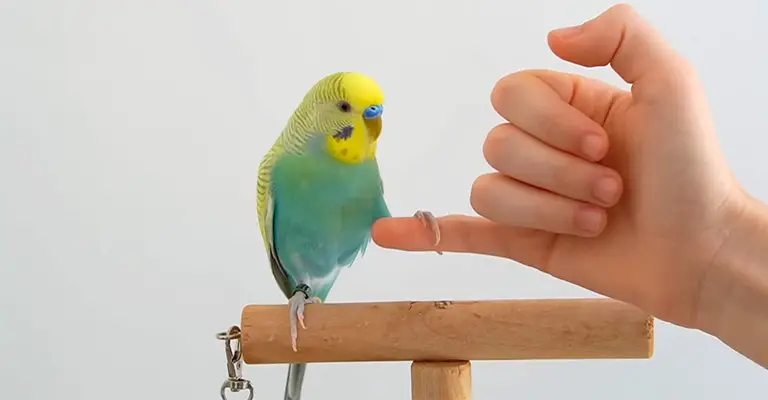
Gaining Trust Before Training A Parakeet
Building a solid foundation of trust is essential before beginning the training process for a parakeet. Parakeets, also known as budgerigars, are intelligent and social birds that can be trained to perform various tricks, mimic sounds, and even develop a bond with their human caretakers.
To establish trust with a parakeet, follow these essential steps:
Creating A Suitable Environment
Before bringing a parakeet home, ensure that you have set up an appropriate and comfortable living environment for them.
Provide a spacious cage with plenty of room for flying, perches of varying sizes, toys for mental stimulation, and a balanced diet consisting of seeds, pellets, fruits, and vegetables.
Respect Their Space
When introducing your parakeet to its new surroundings, give it time to adjust and explore at its own pace.
Avoid sudden movements or loud noises that could startle the bird. Position the cage in a calm area of your home, away from direct sunlight, drafts, or areas with excessive noise.
Patient Observation
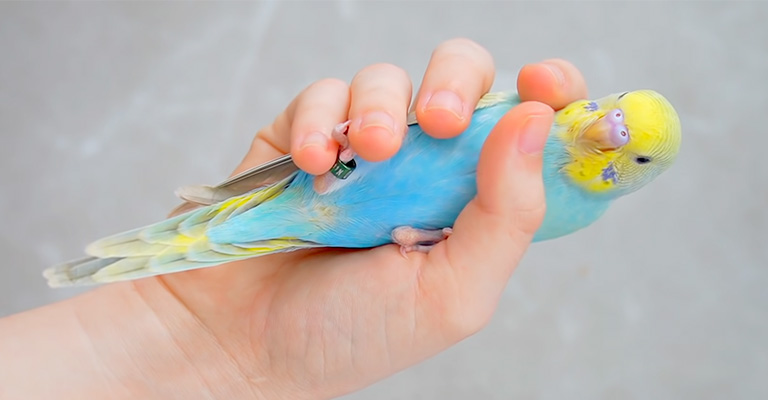
Spend time near the parakeet’s cage, quietly observing its behaviour. This allows the bird to become familiar with your presence without feeling threatened.
Speak softly and avoid making sudden movements during this observation period. Gradually, the parakeet will start to recognise you as a non-threatening presence.
Offering Treats
Treats can be practical tools for building trust with your parakeet. Start by placing small treats on the cage bars or in a dish near the bird, such as millet spray or small pieces of fresh fruit. This positive reinforcement will associate your presence with something enjoyable for the parakeet.
Hand-Feeding
Once your parakeet is comfortable taking treats from a dish, you can progress to hand-feeding. Use a gentle approach and allow the parakeet to approach your hand on its terms.
Place a small treat in the palm of your hand, extending it towards the bird. With time, the parakeet will associate your hand with positive experiences and begin to trust your presence.
Slowly Introduce Interaction
You can gradually introduce interaction as your parakeet becomes more comfortable and trusting.
Begin by offering a finger or a perch for the bird to perch on, allowing it to step onto your hand voluntarily. Avoid grabbing or restraining the parakeet, as this may cause distress and erode the trust you’ve built.
Respect Boundaries:
While training your parakeet, it’s crucial to respect its boundaries. Pay attention to its body language and signals of discomfort, such as fluffing feathers, hissing, or biting.
If your parakeet shows signs of stress, give it some space and try again later. Pushing the bird too far may result in setbacks.
How To Tame A Parakeet?
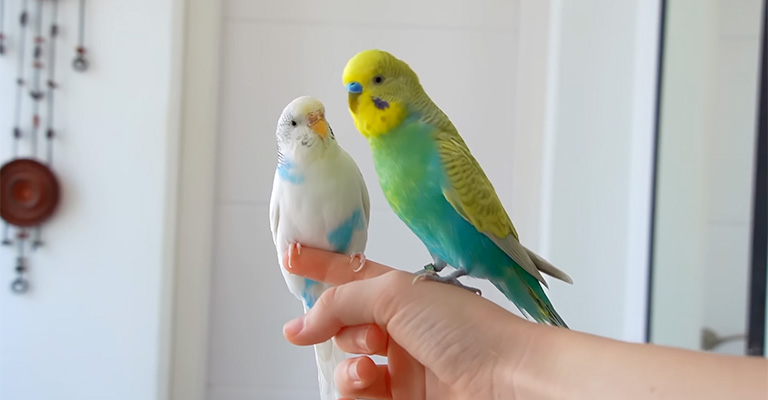
Taming a parakeet involves gradually gaining its trust and building a bond based on positive experiences. With patience and consistency, you can successfully tame your parakeet.
Follow these steps to help in the taming process:
Establish A Safe Environment
Before starting the taming process, ensure the parakeet’s cage is set up in a safe and comfortable space. Provide perches, toys, and various stimulating activities to keep the bird engaged. Ensure the pen is in an area where the parakeet can observe human action without feeling overwhelmed.
Start With Observation
Spend time near the parakeet’s cage, speaking softly and making gentle movements. Observe the bird’s behaviour without making any sudden or threatening gestures. This allows the parakeet to become accustomed to your presence and feel more at ease.
Introduce Your Hand
You can begin introducing your hand once the parakeet seems comfortable with your presence. Place your hand near the cage and keep it still, allowing the parakeet to approach at its own pace.
Avoid making sudden movements that could startle the bird. This step helps the parakeet associate your hand with a non-threatening presence.
Offer Treats
Treats are potent tools for taming parakeets. Start by placing treats, such as millet spray or small pieces of fruit, in your hand or on a dish near the cage.
This positive reinforcement encourages the parakeet to associate your hand with something pleasant and rewarding. Allow the parakeet to approach and take the treats on its terms.
Gradual Hand-Feeding
As the parakeet becomes more comfortable, you can progress to hand-feeding. Hold a treat in your palm, extending it towards the parakeet.
Allow the bird to approach and eat from your hand. Over time, the parakeet will associate your hand with positive experiences and begin to trust your presence.
Slowly Build Physical Contact
Once the parakeet is comfortable taking treats from your hand, you can start building physical contact. Offer a finger or a perch for the parakeet to perch on, allowing it to step onto your hand voluntarily. Avoid grabbing or restraining the bird, which may cause fear or stress.
Gradually Increase Interaction
You can gradually increase interaction as the parakeet becomes more comfortable with your hand. Gently stroke its feathers or scratch its head, always respecting the bird’s boundaries.
Pay attention to its body language and adjust your actions accordingly. Some parakeets may enjoy being gently petted, while others prefer less physical contact.
Maintain A Routine
Consistency is vital when taming a parakeet. Establish a daily routine for feeding, interaction, and training sessions. Parakeets thrive on performance, and a consistent schedule helps them feel secure and build trust more quickly.
Teaching A Parakeet To Step Up And Off
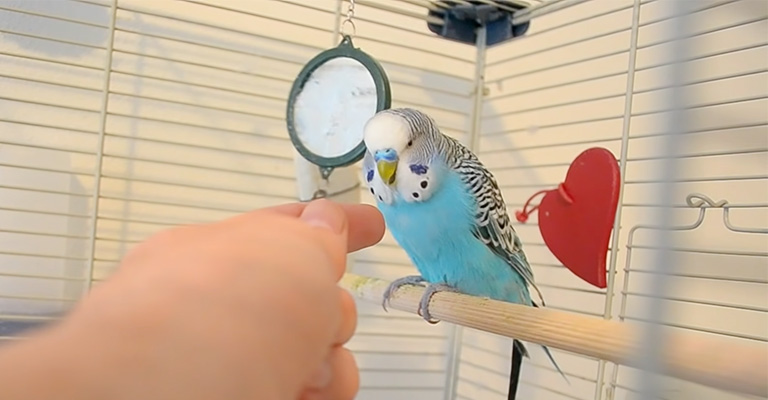
Teaching a parakeet to step up and off your hand or a perch is an essential skill that strengthens the bond between you and your bird and allows for easier handling and interaction.
Follow these steps to teach your parakeet to step up and off:
Prepare A Comfortable Environment
Ensure you are in a calm and quiet area, free from distractions. Choose a suitable perch or use your hand as a landing platform for the training session. Make sure the parakeet feels secure and comfortable in its surroundings.
Use A Command Or Cue
Choose a simple, consistent command or cue to signal your parakeet to step up and off. Examples include “Step up” and “Up and down.” Use a gentle and positive tone when giving the command.
Approach With A Perch Or Your Hand
Position the perch or your hand near the parakeet’s feet below its belly. Slowly and gently approach the bird, allowing it to see the perch or your hand as a safe landing spot.
Target Training
If your parakeet is hesitant to step up, you can use target training as an intermediate step. Hold a small target stick or a chopstick near the parakeet’s feet.
When the bird touches the bar with its beak or feet, offer a reward such as a treat or praise. Repeat this process until the parakeet becomes comfortable targeting the stick.
Encourage Stepping Up
Once your parakeet is comfortable with the perch or your hand nearby, gently apply light pressure to its lower belly or feet, encouraging it to step up.
When the parakeet lifts one foot onto the perch or your hand, offer praise, a treat, or both. Be patient and give the birds time to adjust and understand what is expected.
Reinforce With Rewards
Consistently reward your parakeet with treats, praise, or both each time it successfully steps onto the perch or your hand. Positive reinforcement encourages the desired behaviour and strengthens the command and action association.
Gradually Introduce Stepping Off
Once your parakeet is comfortable stepping up, you can introduce the concept of stepping off. Tilt your hand or the perch slightly to encourage the parakeet to step off onto its cage or another designated area. Again, offer praise and treats as a reward for compliance.
Repeat And Practice
Repetition and practice are crucial to solidifying the step-up and step-off commands. Regularly engage in short training sessions to reinforce the behaviour and build your parakeet’s confidence.
Remember, each parakeet learns at its own pace. Be patient, consistent, and always use positive reinforcement.
Parakeet Training Tips
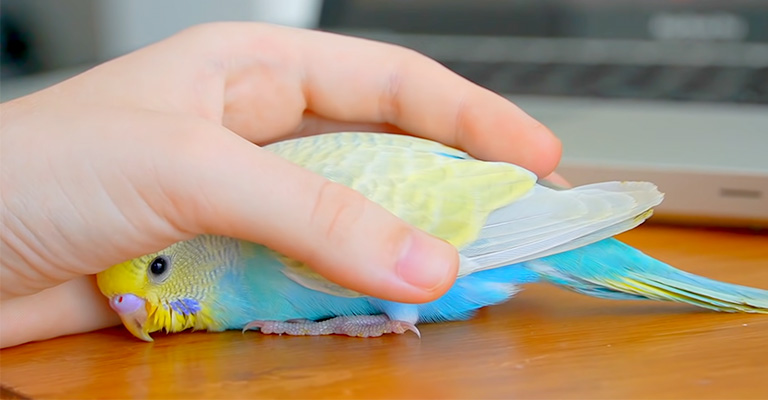
Here are some tips on parakeet training-
Start Early
Train your parakeet as soon as you bring it home. Younger birds are more receptive to learning and adapting to new behaviours.
Be Patient
Parakeets require time to build trust and learn new commands. Approach training with patience and understanding, allowing your bird to progress at its own pace.
Short Training Sessions
Parakeets have shorter attention spans, so keep training sessions brief, around 5 to 10 minutes, to prevent boredom and maintain focus.
Use Positive Reinforcement
Reward desired behaviours with treats, praise, or both. Positive reinforcement helps your parakeet associate training with positive experiences and encourages them to repeat the behaviour.
Consistency Is Key
Consistency in training methods, cues, and rewards is crucial. Use the same command or signal for each behaviour and reward consistently to avoid confusion.
Train In A Distraction-Free Environment
Choose a quiet, distraction-free area for training sessions. This will help your parakeet focus on learning and minimise external factors that may disrupt their attention.
Break Down Behaviors Into Steps
Complex behaviours can be broken down into smaller, manageable steps. Teach one step at a time and gradually combine them as your parakeet becomes proficient.
Gradual Progression
Progress gradually from simple to more advanced behaviours. Mastering more straightforward commands will build your parakeet’s confidence and make it easier for them to understand and learn more complex behaviours.
Respect Boundaries
Pay attention to your parakeet’s body language and cues to understand when they are uncomfortable or need a break. Pushing too hard can cause stress and hinder progress.
Training As Enrichment
Incorporate training as part of your parakeet’s overall enrichment. Mental stimulation through training activities can help prevent boredom and promote a happy, healthy bird.
Train At The Right Time
Choose a time of day when your parakeet is most active and receptive to training. Avoid training during their resting or sleeping periods.
Be A Role Model
Parakeets are observant and can learn by watching their human caretakers. Show them desired behaviours, such as stepping up or interacting with toys, to inspire imitation.
Enjoy The Process
Training sessions should be enjoyable for you and your parakeet. Keep a positive attitude, have fun, and celebrate small victories.
FAQ
Seeds, fruits, vegetables, nuts, and commercial treats. Limit treats to 10% of the diet.
Look at the cere’s colour (fleshy area above the beak). Blue or purple for males, brown or pink for females. It may vary by age and breed.
Avoid touching when aggressive or uncomfortable. Respect personal space and boundaries. Provide toys and activities. Train with positive reinforcement. Use firm and consistent commands.
Spend time with your bird every day. Introduce to other people and pets gradually and positively. Consider getting another parakeet as a companion.
Repeat words or phrases often and consistently. Use a high-pitched and enthusiastic voice. Reward with treats and praise. Be patient and persistent.
Conclusion
Training a parakeet can be a rewarding and enjoyable experience for both the bird and the owner. Parakeets can learn various behaviours and tricks by creating a positive and consistent training environment, establishing trust, and using positive reinforcement techniques. Patience, consistency, and a gentle approach are essential when training these intelligent and social birds.
Always prioritise their well-being and provide a safe and stimulating environment for them to thrive. With time and effort, your parakeet can become a well-trained and delightful companion, showcasing their unique abilities and bringing joy to your life.